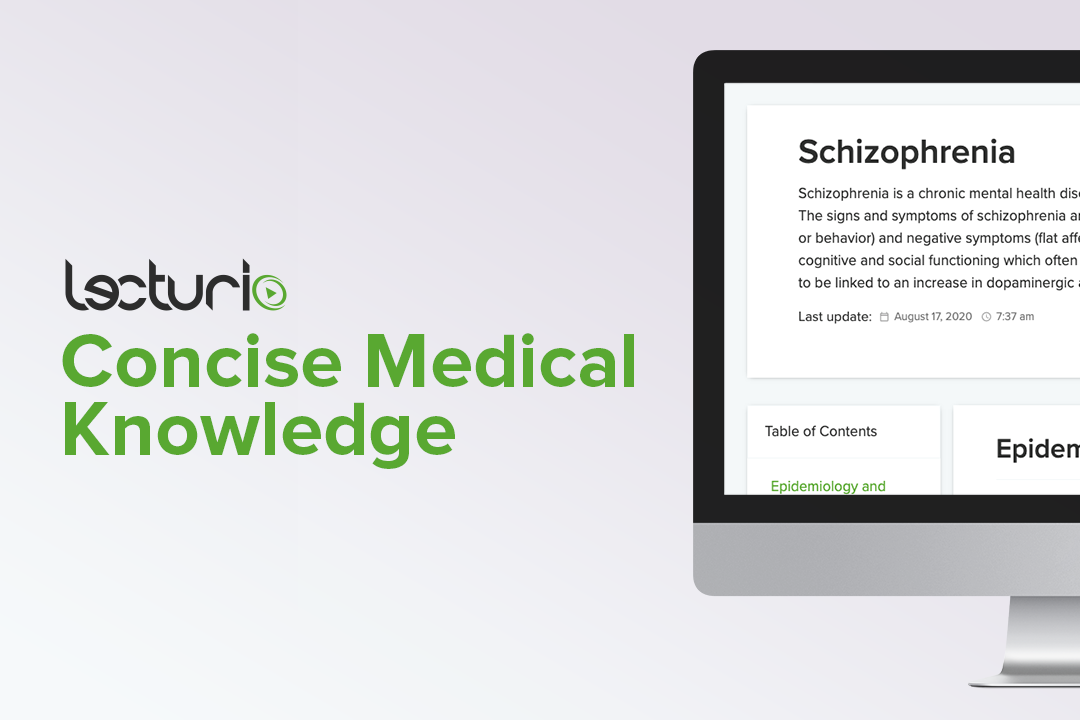Playlist
Show Playlist
Hide Playlist
Schizophrenia: Assessment
-
Slides Schizophrenia Psychiatry.pdf
-
Download Lecture Overview
00:01 There are 3 essential phases of schizophrenia. 00:05 So, the first phase is called the prodromal. 00:08 This is where a person has a decline in functioning that precedes the first psychotic episode. 00:14 Patients may become socially withdrawn and irritable during this phase. 00:20 Next, they have the psychotic symptoms. 00:23 This is where there are perceptual disturbances, delusions, disorganized thought process and content. 00:30 And then, there is a residual phase. 00:32 This occurs between episodes of psychosis and it’s marked by a flat affect, social withdrawal and odd thinking or behaviors. 00:42 Another question to consider, what is the strongest predictor of treatment outcome in a first-episode of a psychotic break or a first diagnosis of schizophrenia? The answer is the duration of presenting symptoms before treatment. 01:01 So for example, if somebody gets into treatment very early when they’ve only had symptoms for a brief period of time, they are much more likely to have a good treatment response and outcome than somebody who’s languishing with psychotic symptoms for weeks, months or even years before ever getting into treatment. 01:21 Here’s another question. 01:23 What subtype of schizophrenia is associated with a better short and long-term outcome? The specific subtype is the paranoid subtype. 01:33 This has the best treatment outcome, short and long-term. 01:38 Earlier in this lecture, I have referenced positive and negative symptoms a lot. 01:43 So you might be asking yourself what are these positive and negative symptoms. 01:47 Well, there are way that we classify the symptoms associated with schizophrenia and there are several types as you can see here. 01:56 Maybe take a moment and try to think to yourself which category each symptoms falls under. 02:03 The positive symptoms usually being the more active, expansive type symptoms and negative symptoms being the more quiet, withdrawn type of symptoms. 02:14 So see if you can assign the correct symptom to the correct category. 02:19 This is the answer. 02:20 Positive symptoms of schizophrenia include things like disorganized thoughts, bizarre behavior, delusions, and hallucinations. 02:28 Negative symptoms are things like blunted or flat affect, inattentiveness, apathy and anhedonia. 02:35 What are Schneider’s first-rank symptoms of psychosis? Well, the answers are hallucinations, delusions, thought insertion, thought withdrawal and thought broadcasting. 02:50 Well, who is Schneider? Kurt Schneider was a German psychiatrist known largely for his writing on the diagnosis and understanding of schizophrenia. 03:00 Back in the 1970s, he coined the first-rank symptoms that we just reviewed. 03:07 Another important history lesson is the 5 A’s of schizophrenia that tend to be associated with negative symptoms. 03:15 These include anhedonia, flat affect, allogia or in other words poverty of speech, avolition, in other words apathy, and attention being very poor. 03:30 Well, who defined the 5 A’s of schizophrenia? The answer is Eugen Bleuler, who was the one to coin the term schizophrenia in 1908. 03:41 But prior to him, Emil Kraeplin coined another term to refer to patients with schizophrenia. 03:49 Do you know what that term was? It’s dementia praecox. 03:53 We talked earlier a little bit about head imaging in schizophrenia and how hypofrontality is very important and a prominent sign. 04:02 And so just to reiterate, schizophrenia can appear on a head CT scan as ventricular enlargement and also cortical atrophy, although keeping in mind, these are nonspecific findings. 04:15 Let’s consider this case of Mr. B. 04:19 He is a 22-year-old man who’s having trouble in college. 04:22 Rather than graduating on time, he has had to repeat a few years due to inability to get to class because he’s low on motivation. 04:30 His parents come out to college to visit him and they find that his dorm room is a mess. 04:35 Their son, Mr. B, is malodorous. 04:38 He hasn’t been showering or taking care of his hygiene. 04:41 He is talking nonsense when his parents ask him what’s wrong. 04:45 The only thing they can decipher from him is that he is saying, “My professor wants to kill me.” Based on your knowledge of the different types of thought disorder and delusions, what types of symptoms are most prominent in Mr. B? Well, he is having both positive and negative symptoms of psychosis. 05:09 He appears to be having paranoid delusions about his professor and he is not making much sense as parents say he is nonsensical, which indicates he may have a thought disorder happening. 05:21 He also seems to be withdrawn. 05:23 He is staying in his room. 05:25 He is unmotivated. 05:26 He is not going to class. 05:27 His room is a mess and he has also neglected his personal hygiene. 05:32 Really important to note that someone like Mr. B or any patient with schizophrenia must be assessed for suicide risk. 05:40 I can’t overemphasize that enough. 05:42 The suicide risk assessment is important for every patient including the patient with schizophrenia or psychotic disorder. 05:49 Approximately 10% of patients with schizophrenia will actually commit suicide. 05:57 And so, what are the risk factors for suicide in a patient with schizophrenia? Well, we consider these to be some of the risk factors: Male gender, being under the age of 30, being paranoid, having a comorbid substance abuse problem, be it drugs or alcohol, having associated depressive symptoms, unemployment, frequent recurrences or exacerbations of their disease and symptoms, any prior suicide attempt, living alone and maybe having a recent hospitalization. 06:32 These are all the some of the risk factors that you want to make sure to ask about. 06:36 So, what is at the core of schizophrenia? Well, negative symptoms of schizophrenia are considered the core of the disease and unfortunately, they’re also the most difficult to treat. 06:51 Let’s go through the diagnostic criteria for schizophrenia. 06:55 So patient needs to have two or more of the following symptoms, each have to be present for significant amount of time over a consecutive one month period. 07:06 So, that’s delusions, hallucinations, disorganized speech, grossly disorganized behavior and negative symptoms. 07:18 Furthermore, that patient also has to have been affected by the disorder in various domains of their life including social and occupational functioning. 07:28 And the signs of the disturbances have persisted for at least six months. 07:34 So even if the criterion A is only active for a month, the impact to ones social and occupational functioning extends for at least 6 months or longer. 07:47 Also, the other disorders associated with psychotic features such as schizoaffective disorder and mood disorder with psychotic features have to have been ruled out before somebody can be diagnosed with schizophrenia. 08:03 The person has to be ruled out for having symptoms that could be attributed to substances or general medical condition. 08:15 Brief Psychotic Disorders: Presence of psychotic symptoms as in schizophrenia; however, symptoms last from 1 day to 1 month and there must be eventual return to baseline function at the end of the event. 08:31 Symptoms must not be due to substances or a general medical condition. 08:37 Schizophreniform Disorder: The diagnosis is made using the same DSM-5 criteria as schizophrenia. 08:45 The only difference is that the symptoms have lasted between 1 and 6 months, whereas in schizophrenia the Symptoms persist beyond 6 months. 08:57 Schizoaffectivec Disorders: Patient meets criteria for either a major depressive or manic episode during which psychotic symptoms consistent with schizophrenia are also met. 09:13 Delusions or hallucinations for 2 weeks in the absence of mood disorder symptoms. 09:20 Mood symptoms are present for the majority of the psychotic illness and symptoms are not due to the effects of a substance or other medical condition. 09:30 Thinking back to this case study of Mr. B, I want you to think about what would your diagnosis be of him? So of course, you’ve ruled out all substance issues, all medical conditions that could be contributing to his presentation and also other psychiatric disorders would need to be ruled out before you can attribute his condition to schizophrenia. 09:53 And again, when I say other psychiatric disorders, we are talking about brief psychotic disorder, schizophreniform disorder, schizoaffective disorder or mood disorder with psychotic features. 10:05 Also, his symptoms would have to be confirmed as present for at least six months before it could be attributed to schizophrenia. 10:14 If schizophrenia is diagnosed, Mr. B and his family should be engaged actively in a treatment options geared towards helping Mr. B experience relief from his symptoms and to help him function within society.
About the Lecture
The lecture Schizophrenia: Assessment by Helen Farrell, MD is from the course Schizophrenia and Thought Disorders. It contains the following chapters:
- Three Phases of Schizophrenia
- Different Symptoms of Psychosis
- Five As of Schizophrenia
- Schizaphrenia Assessment
Included Quiz Questions
Which phase of schizophrenia is marked by flat affect, social withdrawal and odd thinking or behavior?
- Residual phase
- Prodromal phase
- Convalescence phase
- Psychotic phase
- Intermittent phase
All the following are risk factors for suicide in the patient with schizophrenia, EXCEPT:
- Female gender
- Age under 30
- Comorbid substance abuse
- Living alone
- Recent hospital discharge
Which of the following sentences about schizophrenia is NOT true?
- Approximately 30% of the patients commit suicide.
- There are 3 phases of schizophrenia.
- Head CT scan can show ventricular enlargement and cortical atrophy.
- Eugen Bleuler coined the term schizophrenia.
- Negative symptoms are considered as the core and are difficult to treat.
Which of the following is NOT criteria for diagnosing schizophrenia?
- An underlying medical condition that justifies psychotic behavior must be present.
- If the patient has a history of pervasive developmental disorder, the additional diagnosis of schizophrenia is made only if prominent delusions or hallucinations are present for at least a month (or less if successfully treated).
- The disorder affects domains of life including social and occupational functioning.
- Not due to substances or a general medical condition.
- Schizoaffective disorder and mood disorder with psychotic features have been ruled out.
Customer reviews
5,0 of 5 stars
| 5 Stars |
|
1 |
| 4 Stars |
|
0 |
| 3 Stars |
|
0 |
| 2 Stars |
|
0 |
| 1 Star |
|
0 |
This lecture is a very good one and its contents are precise. I will definitely recommend this lecture to anyone.




